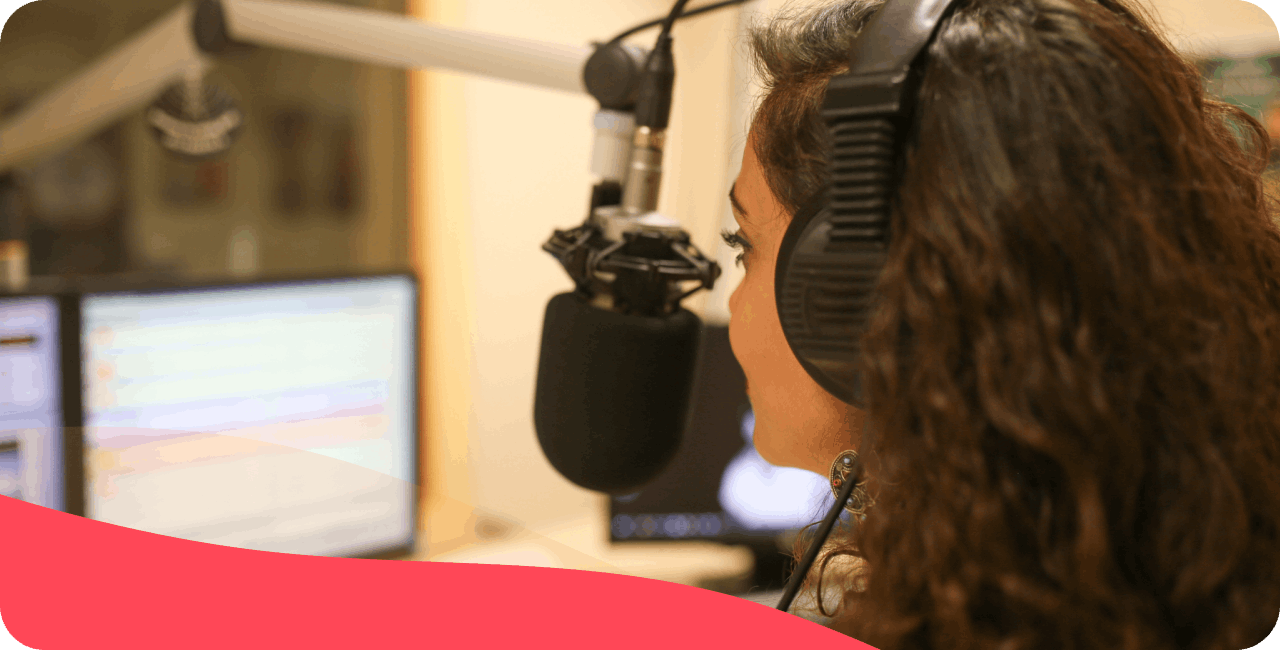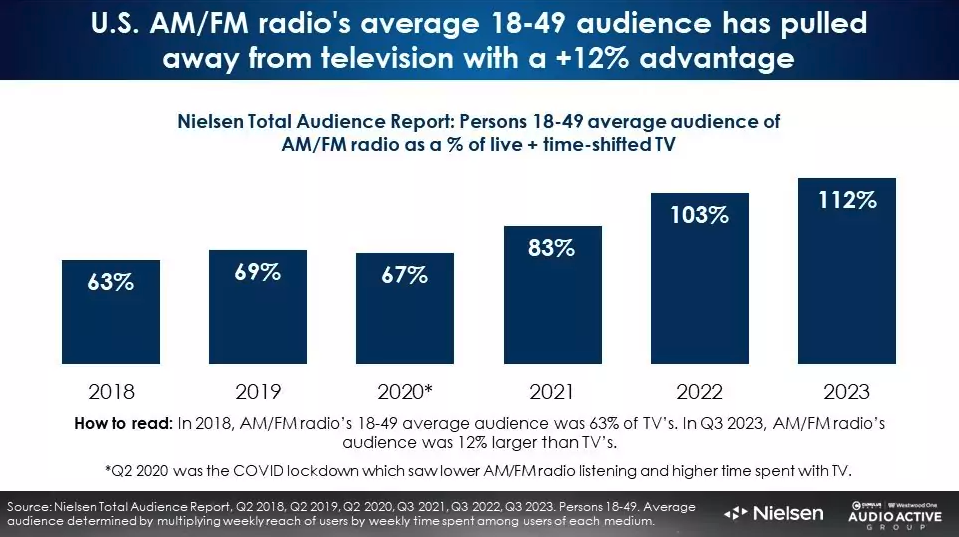Many may think of radio as a dying industry, but recent statistics have shown the opposite. According to Nielsen’s Q3 2023 Total Audience Report, radio remains the most popular media in America, reaching 84% of the population aged 18+. The numbers speak for themselves on the popularity of audio broadcasting, but why do people still listen to radio? Let’s take a look!
1/ Accessibility and convenience
2/ Local content
3/ Music discovery
4/ Talk Shows and News
5/ Companionship
Technological Evolution
The constant evolution of radio throughout the years has made it a media that adapts to it’s time, helping it to stay relevant even today. It all began with the discovery of electromagnetic waves by Heinrich Hertz in the late 19th century, which paved the way for Guglielmo Marconi’s pioneering work in wireless telegraphy. Marconi’s successful transmission of radio signals across the Atlantic in 1901 marked the start of practical radio communication. In the 1920s, radio transitioned from a tool for military and maritime communication to a medium for mass entertainment and news, with the establishment of the first commercial radio stations.
The development of FM broadcasting in the 1930s by Edwin Armstrong improved sound quality and expanded its reach. Subsequent decades saw radio adapt to new technologies, such as transistor radios in the 1950s, digital broadcasting in the late 20th century, and internet radio in the 21st century, maintaining its relevance in the ever-changing landscape of media and communication.
Why do people still listen to the radio?
Now let’s dive into 5 reasons why people still listen to radio.
1. Accessibility and Convenience
Easy access
Radio stands out for its accessibility and convenience, offering an audio medium that reaches a broad audience without the need for expensive equipment. Its simplicity and portability allow listeners to tune in from virtually anywhere, whether at home, in a car, or on the go with a portable device. This makes radio a vital source of information and entertainment, particularly in remote or underdeveloped areas where other forms of media might be less accessible.
Additionally, radio broadcasts can be accessed easily through a wide range of devices, from traditional receivers to modern smartphones, ensuring that groups of all ages and technological backgrounds can stay informed and connected.

A convenient medium
Nowadays, you no longer need to fumble around on a dial to tune in to the right station. In your car, you can switch stations with the simple press of a button and thanks to the arrival of Internet radio streaming, listening has never been easier! Plus, unlike other media such as TV or podcasts, you can tune in and out of a radio broadcast whenever you like. You don’t need to follow a broadcast from start to finish in order to understand it (especially when it comes to the music format.) Finally, traditional broadcasting is free to access, providing a wide range of content without requiring a subscription or purchase.
2. Local Content
The role of community radio
Community stations play a crucial role in in the radio industry. They foster community identity and engagement by delivering news, stories, and music that resonate with local audiences. It offers a platform for discussing regional issues, celebrating local culture, and promoting events, thereby strengthening community bonds.
Local radios often feature programs that highlight local artists, provide a forum for community leaders and residents to voice their opinions, and offer coverage of local sports and events, which larger, national stations might overlook. This focus on the local scene ensures that listeners receive relevant and timely information, helping them stay connected to their immediate environment. By catering to the unique tastes and interests of the community, local radio not only informs but also entertains and unites its audience, reinforcing a sense of shared experience and local pride.

Local presenters
Radio hosts that comes from the same area as you create a familiar atmosphere and a sense of proximity. They enhance the listening experience through a personal and relatable connection. Local hosts are often deeply embedded in the community they serve, bringing a unique perspective and understanding of local issues, culture, and events. Their familiarity with the community allows them to tailor content to the consumer’s interests, from playing favorite local music to discussing community concerns. This personalized approach encourages a sense of community and trust, as listeners feel more connected to someone who shares their local experiences and understands their specific needs.
Plus, local hosts can spotlight local businesses, events, and personalities, contributing to the economic and social vitality of the area. The intimate and interactive nature of local radio hosting often leads to higher listener engagement and loyalty. This helps create a strong, supportive community network.
3. Music Discovery
Discovering new music and artists is another key reason as to why people still listen to the radio. Although not all radios are solely music-based, it remains a popular format for many broadcasters today. It’s a highly popular format for listeners too, who listen to the radio on their daily commute, or to relax at the end of the day.
Music radio stations often target a specific genre or era, providing specially curated playlists for their target audience. Not only do listeners benefit from their favourite tracks and artists, it’s also a great way for them to discover new songs that they are likely to enjoy. There are also many radios that broadcast a variety of musical genres to provide their consumers with a rich and diverse listening experience. This opens the doors for unexpected finds and allows individuals to discover music that they may not have thought to listen to on their own.
4. Talk Shows and News
A direct connection
Live talk shows are another format that attract a large number of radio listeners. The popularity of live talk shows, interviews and listener call-ins is what makes radio stand out from other audio media. Radio hosts seek a direct connection with their listeners by including them in the life of the radio show. This sets this format apart from podcasts for example. This format makes for great engagement! Whether it’s through radio contests, or specific radio shows that invite listeners to share their own stories.

Real-time
Tuning in to live radio is also a great way to keep informed of the news updates in the moment. The ability to broadcast to large audiences with minimal infrastructure also means that radio remains a crucial tool for emergency communication, providing timely updates and critical information during crises. Modern radio stations also frequently use social media to interact with listeners, allowing for real-time feedback and engagement.
5. People still listen to the radio for companionship
Human connection
Despite the expansion of modern digital media, people continue to tune in to the radio for companionship. Many find comfort and connection in the familiar voices and engaging content it provides. Radio hosts often become trusted friends to their listeners, offering a sense of presence and consistency throughout the day. This is particularly significant for those who might feel isolated, such as the elderly, remote workers, or individuals living alone. The live nature of radio broadcasts creates an immediate, shared experience that creates a sense of belonging and reduces feelings of loneliness. Listeners can tune in for uplifting music, engaging talk shows, and real-time interactions, such as call-ins and shout-outs, which enhance the feeling of community.

Daily presence
Regularly scheduled programs and familiar voices create a sense of consistency and reliability. Loyal listeners develop a bond with the hosts and the station’s format. Many people incorporate listening to the radio into their daily routines. Whether it’s during their commute, at work, or at home, it strengthens the habitual connection. The companionship offered by radio is uniquely intimate. It accompanies many through their daily routines, providing a reliable and comforting backdrop to their lives. Whether they tune in to specific programs at a designated time, or simply have the station on in the background. Radio has forged a way into the day-to-day life of many.
Fun facts about radio consumption
- More Americans listen to the radio (293 million) than use Facebook (180 million). (Nielsen Media Research)
- 55% of Gen Z in the U.S. tune in to AM/FM radio every day. (Edison Research)
- 88% of American adults listen to the radio for 12.2 hours per week. (Nielsen Media Research)
- 77% of listeners would try a brand or product recommended by their favorite radio personality. (Katz Radio Group)
- 47% of listeners believe radio ads are a fair trade for their listening time. (NPR research)
So, do people still listen to the radio? Yes! By continuing to evolve over the past century, radio has managed to remain a relevant medium. People still listen to radio as it’s extremely easy to access through various devices. Local content is incredibly popular, creating a sense of proximity between listener and host with information that concerns them directly. Music discovery also plays a big role in the popularity of this medium, providing diversity and a rich listening experience. Live shows are a unique audio format that many enjoy. You get to live in the moment with broadcaster and a whole community that are tuning in simultaneously. Finally, radio is a great companion that offers human connection in the day-to-day lives of many.
Want to create your own radio station? Get started for free today with RadioKing!

